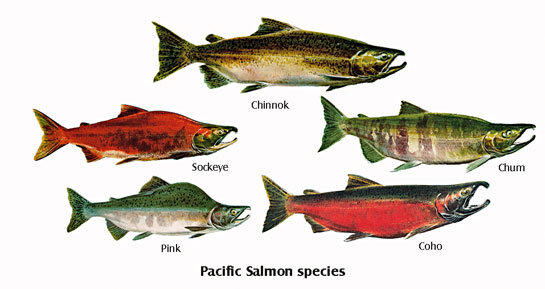Salmon
/Salmon have and continue to be an important part of Washington life. They are important food sources for many other animals on land, in freshwater, and in saltwater. Because Native Peoples who lived in this area relied on salmon as an important food source, salmon also became an important part of native culture. It remains an important part of the history and culture of Washington today.
Salmon are part of the family Salmonidae which also includes trout and charr. Often members of this family are referred to as “Salmonids.” Many of the fish in this family are anadromous, meaning they spend time both in salt and fresh water. In order to do this, their body must go through changes so they can survive in each habitat.
Types of Salmon in WA
Pacific Salmon in Spawning form Photo: https://www.sanctuaryasia.com/magazines/talkin-tigers/9581-the-pacific-salmons-journey.html
There are 5 salmon species in Washington. An fun way to remember them is relating the types of salmon to each finger on your hand. Hold out one hand and with your other hand point to your thumb. Your thumb represents the Chum Salmon because Chum and thumb rhyme. Chum Salmon are sometimes called Dog Salmon probably because the spawning males develop teeth that kind of look like canine teeth. Point to your pointer finger. With this finger you could accidentally “sock yourself in the eye” so it stands for the Sockeye Salmon. Young Sockeye salmon live in lakes for up to two years before migrating to the ocean. Point to your middle finger. Because this is your tallest finger it represents the largest salmon species, Chinook Salmon. Sometimes these salmon are known as King Salmon and they are the preferred food of our resident population of Orcas. Next is your ring finger. Because you might place a silver ring on this finger, it represents the “Silver Salmon,” also known as Coho Salmon. These salmon often spawn in small streams that are close to neighborhoods, making them a popular sport fish. Lastly, your pinky finger represents the Pink Salmon. These salmon develop a hump in their spawning form, earning the nickname “Humpback Salmon.” They also only spawn in odd years because they have a very regular life cycle where they return to their home stream to spawn after living in the ocean for 2 years. There are 3 other Salmonids native to Washington: Steelhead, Bull Trout and Cutthroat.
Salmon Life Cycle
All species of salmon have a slightly different life cycle. They may spend more time in one stage than other salmon do. This is the general life cycle of salmon: Salmon start their lives as eggs in the gravel of a stream bed. Once they hatch, they still have their yolk sac and they use this as nutrients to grow larger. This stage is called the alevin. Once their yolk sac is absorbed, they become fry and need to start finding their own food. They eat freshwater invertebrates. When the salmon start heading to saltwater, their body starts going through a process called “smoltification” so they can survive in the salty water. This next stage is therefore called a smolt. Estuaries, like the Puget Sound, are incredibly important transition zones between fresh and salt water for this stage of salmon. Eventually the salmon becomes an adult, living a portion of its life in the ocean. When it is time to spawn, or lay eggs, salmon pass through the estuary again and their body changes to tolerate the saltwater. They are able to locate the same stream they were hatched in through their sense of smell! At this time, the salmon stops eating, mates, and finds a place to lay their eggs. After they lay their eggs, the salmon’s journey is over and they die.
So how exactly do Salmon help forests grow?
A salmon’s life is not an easy one. They face multiple predators throughout their life cycle including: birds, bears, other fish, sharks, orcas, and humans. On top of this, salmon are also facing man-made threats of habitat destruction, pollution, dams, and overfishing. A spawning salmon may lay somewhere between 1,500 to 10,000 egg and only around 10 will survive to reproduce. So what do salmon have to do with the forest? As salmon are hunted by land predators such as birds and bears, these predators carry the salmon on to land. They may not always finish their meal, leaving food for other animals such as foxes, raccoons and invertebrates. The rotting fish as well as the waste the animals produce after eating the fish give nutrients (mainly nitrogen) to the soil in the forest, helping many plants grow. After a salmon spawns, they also end up on riverbanks to be decomposed and turned into nutrients that feeds the plants of the forest. So salmon are not only important food sources for many animals, they also help feed the trees! Learn more here: https://www.kqed.org/science/1915421/theres-something-fishy-about-these-trees-deep-look






